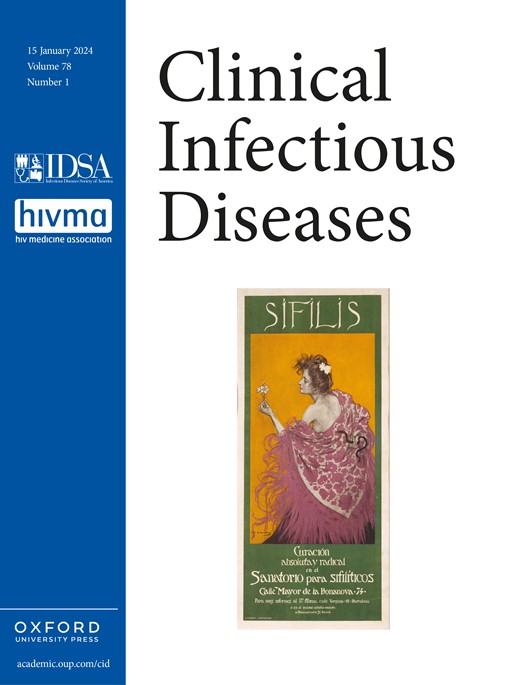2001-2019 年期间美国不同种族和族裔以及不同风险群体艾滋病毒感染者癌症发病率趋势的差异
IF 8.2
1区 医学
Q1 IMMUNOLOGY
引用次数: 0
摘要
背景 由于采用了抗逆转录病毒疗法,艾滋病病毒感染者(PWH)的癌症风险随着时间的推移有所下降,但目前尚不清楚是否所有种族/民族群体和传播风险群体的癌症风险都出现了同样的下降。方法 我们使用了 2001-2019 年期间艾滋病毒/艾滋病癌症配对研究中年龄≥20 岁的 PWH 数据。我们使用泊松回归评估了按种族/人种和风险组别划分的各癌症部位发病率的时间趋势,并对年龄、登记和性别进行了调整。我们还估算了 2001-2004 年和 2015-2019 年不同种族、族裔和风险组的调整后比率。结果 黑人、白人和西班牙裔公共卫生人员以及某些癌症的不同风险群体的年龄标准化发病率趋势各不相同。例如,肝癌发病率在白人公共卫生人员中每 5 年下降 23%,在黑人公共卫生人员中下降 11%,在西班牙裔公共卫生人员中下降 18%。在2001-2004年和2015-2019年期间,按种族/族裔划分的癌症发病率相对差异在HL和肝癌方面有所上升,但在NHL方面有所下降;按风险群体划分,NHL和肝癌的相对差异有所上升,而HL、肺癌和肛门癌的相对差异有所下降。结论 2001-2019 年期间,在美国的威尔士人中,不同种族/族裔群体的 HL、肺癌、肝癌和宫颈癌发病率趋势各不相同。不同风险群体的乳腺癌、肺癌、肛门癌和肝癌发病率趋势也不同。未来的工作应研究造成趋势差异的根本原因。本文章由计算机程序翻译,如有差异,请以英文原文为准。
Differences in Trends in Cancer Incidence Rates Among People with HIV during 2001–2019 By Race and Ethnicity and By Risk Group in the United States
Background Cancer risk among people with HIV (PWH) has declined over time as a result of antiretroviral therapy, but it is unclear whether all racial/ethnic groups and transmission risk groups have experienced equal declines. Methods We used data on PWH aged ≥20 years old from the HIV/AIDS Cancer Match Study during 2001–2019. We used Poisson regression to assess time trends in incidence rates for each cancer site by racial/ethnicity and risk group, adjusting for age, registry, and sex. We also estimated adjusted rate ratios across racial and ethnic and risk groups in 2001-2004 and 2015-2019. Results Trends in age-standardized rates differed across Black, White and Hispanic PWH, and across risk groups for some cancers. For example, liver cancer rates declined 23% per 5-year period among White PWH, 11% in Black PWH and 18% in Hispanic PWH. Anal cancer rates declined among men who have sex with men, were stable among people who inject drugs, and increased among other risk groups Between 2001-2004 and 2015-2019, relative difference in cancer incidence rates by race/ethnicity increased for HL and liver cancer but decreased for NHL; by risk group, relative differences increased for NHL and liver cancer, and decreased for HL, lung and anal cancers. Conclusions Among PWH in the US, during 2001–2019, HL, lung, liver, and cervical cancer rate trends were different across racial/ethnic groups. HL, lung, anal, and liver cancer rates trends were different across risk groups. Future work should examine underlying causes of the differences in trends.
求助全文
通过发布文献求助,成功后即可免费获取论文全文。
去求助
来源期刊

Clinical Infectious Diseases
医学-传染病学
CiteScore
25.00
自引率
2.50%
发文量
900
审稿时长
3 months
期刊介绍:
Clinical Infectious Diseases (CID) is dedicated to publishing original research, reviews, guidelines, and perspectives with the potential to reshape clinical practice, providing clinicians with valuable insights for patient care. CID comprehensively addresses the clinical presentation, diagnosis, treatment, and prevention of a wide spectrum of infectious diseases. The journal places a high priority on the assessment of current and innovative treatments, microbiology, immunology, and policies, ensuring relevance to patient care in its commitment to advancing the field of infectious diseases.
 求助内容:
求助内容: 应助结果提醒方式:
应助结果提醒方式:


